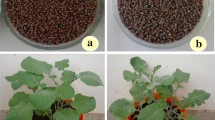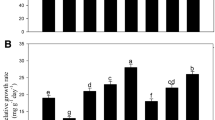Abstract
Mustard (Brassica juncea L.) cultivars Alankar (salt-tolerant) and PBM16 (salt-sensitive) plants were grown with 50 mM NaCl and were sprayed with 0.1, 0.5, and 1.0 mM salicylic acid (SA) to study the physiological processes determining salt tolerance and to observe the influence of SA application on the alleviation of NaCl-induced adverse effects. The content of leaf Na+, Cl−, H2O2, TBARS, and electrolyte leakage and the activity of SOD were higher in PBM16 than Alankar. In contrast, nutrients content, activity of APX and GR, glutathione content, photosynthetic and growth characteristics were higher in Alankar. Treatment of 50 mM NaCl resulted in increase of Na+ and Cl−, oxidative stress, activity of antioxidant enzymes and glutathione content, while nutrients content, photosynthetic, and growth characteristics decreased in both the cultivars. Application of 0.5 mM SA alleviated the negative effects of 50 mM NaCl maximally, but 1.0 mM SA proved inhibitory. The effect of SA was more conspicuous in Alankar than PBM16. It is concluded that the higher tolerance of Alankar was due to its lower leaf Na+ and Cl− content, higher nutrients content, and efficient antioxidant metabolism. The application of 0.5 mM SA substantially alleviated salt-induced adverse effects in Alankar.







Similar content being viewed by others
Abbreviations
- APX:
-
Ascorbate peroxidase
- CA:
-
Carbonic anhydrase
- CAT:
-
Catalase
- DAS:
-
Days after sowing
- GR:
-
Glutathione reductase
- C i :
-
Intercellular CO2 concentration
- P N :
-
Net photosynthetic rate
- NBT:
-
Nitroblue tetrazolium
- GSSG:
-
Oxidized glutathione
- ROS:
-
Reactive oxygen species
- GSH:
-
Reduced glutathione
- SA:
-
Salicylic acid
- g s :
-
Stomatal conductance
- SOD:
-
Superoxide dismutase
- TBARS:
-
Thiobarbituric acid reactive substances
References
Al-Hakimi AMA, Hamada AM (2001) Counteraction of salinity stress on wheat plants by grain soaking in ascorbic acid, thiamin or sodium salicylate. Biol Plant 44:253–261
Alpaslan M, Gunes A (2001) Interactive effect of boron and salinity stress on the growth, membrane permeability and mineral composition of tomato and cucumber plants. Plant Soil 236:123–128
Anderson ME (1985) Determination of glutathione and glutathione disulfides in biological samples. Methods Enzymol 113:548–570
Arfan M, Athar HR, Ashraf M (2007) Does exogenous application of salicylic acid through the rooting medium modulate growth and photosynthetic capacity in two differently adapted spring wheat cultivars under salt stress? J Plant Physiol 164:685–694
Arshi A, Abdin MZ, Iqbal M (2005) Ameliorative effect of CaCl2 on growth, ionic relations and proline content of senna under salinity stress. J Plant Nutr 28:101–125
Ashraf M (2004) Some important physiological selection criteria for salt tolerance. Flora 199:361–376
Beyer WF, Fridovich I (1987) Assaying for superoxide dismutase activity: some large consequences of minor changes in conditions. Anal Biochem 161:559–566
Bohnert HJ, Jensen RG (1996) Strategies for engineering water-stress tolerance in plants. Trends Biotech 14:89–97
Bohnert HJ, Nelson DE, Jensen RG (1995) Adaptations to environmental stresses. Plant Cell 7:1099–1111
Borsani O, Valpuesta V, Botella MA (2001) Evidence for a role of salicylic acid in the oxidative damage generated by NaCl and osmotic stress in Arabidopsis seedlings. Plant Physiol 126:1024–1034
Chen HJ, Hou WC, Kue J, Lin YH (2001) Ca2+-dependent and Ca2+-independent excretion modes of salicylic acid in tobacco cell suspension culture. J Exp Bot 52:1219–1226
Clark SM, Laj M, Wood JE, Scott IM (2004) Salicylic acid dependent signaling promotes basal thermotolerance in Arabidopsis thaliana. Plant J 38:432–437
Cramer GR, Lynch J, Lauchli A, Epstein E (1987) Influx of Na, K and Ca into roots of salt-stressed cotton seedlings. Plant Physiol 83:510–516
de Bruxelles GL, Peacock WJ, Dennies ES, Dolferus R (1996) Abscisic acid induces the alcohol dehydrogenase gene in Arabidopsis. Plant Physiol 111:381–391
Dhindsa RH, Plumb-Dhindsa P, Thorpe TA (1981) Leaf senescence correlated with increased level of membrane permeability, lipid peroxidation and decreased level of SOD and CAT. J Exp Bot 32:93–101
Durner J, Klessig DF (1995) Inhibition of ascorbate peroxidase by salicylic acid and 2, 6-dichloro isonicotic acid, two inducers of plant defense responses. Proc Natl Acad Sci USA 92:11312–11316
Durner J, Shah J, Klessig DF (1997) Salicylic acid and disease resistance in plants. Trends Plant Sci 2:266–274
El-Tayeb MA (2005) Response of barley grains to the interactive effect of salinity and salicylic acid. Plant Growth Regul 45:215–224
Erasalan F, Inal A, Gunes A, Alpaslan M (2007) Impact of exogenous salicylic acid on the growth, antioxidant activity and physiology of carrot plants subjected to combined salinity and boron toxicity. Sci Hortic 113:120–128
Fiske CH, Subba Row Y (1925) The colorimetric determination of phosphorus. J Biol Chem 66:375–400
Foyer CH, Halliwell B (1976) The presence of glutathione and glutathione reductase in chloroplasts: A proposed role in ascorbic acid metabolism. Planta 133:21–25
Gapinska M, Sklodowska M, Gabara B (2008) Effect of short- and long-term salinity on the activities of antioxidative enzymes and lipid peroxidation in tomato roots. Acta Physiol Plant 30:11–18
Gechev TS, Gadjev I, Dukiendjiev S, Minkov I (2005) Reactive oxygen species as signaling molecules controlling stress adaptation in plants. In: Pessarakali M (ed) Handbook of photosynthesis, 2nd edn. CRC, Boca Raton, pp 209–218
Giannopolitis CN, Ries SK (1977) Superoxide dismutase. I. Occurrence in higher plants. Plant Physiol 59:309–314
Gossett DR, Millhollon EP, Lucas MC (1994) Antioxidant response to NaCl stress in salt-tolerant and salt-sensitive cultivars of cotton. Crop Sci 34:706–714
Gunes A, Inal A, Alpaslan M, Cicek N, Guneri E, Eraslan F, Guzelordu T (2005) Effects of exogenously applied salicylic acid on the induction of multiple stress tolerance and mineral nutrition in maize (Zea mays L.). Arch Agron Soil Sci 51:687–695
Gunes A, Inal A, Alpaslan M, Eraslan F, Bagci EG, Cicek N (2007) Salicylic acid induced changes on some physiological parameters symptomatic for oxidative stress and mineral nutrition in maize (Zea mays L.) grown under salinity. J Plant Physiol 164:728–736
Hamid M, Ashraf MY, Rehman K, Arshad M (2008) Influence of salicylic acid seed priming on growth and some biochemical attributes in wheat grown under saline conditions. Pak J Bot 40:361–367
Hewitt EJ (1966) Sand and water culture methods used in the study of plant nutrition. Commonwealth Agricultural Bureaux England
Khan NA (1994) Variation in carbonic anhydrase activity and its relationship with photosynthesis and dry mass of mustard. Photosynthetica 30:317–320
Khan W, Prithviraj B, Smith DL (2003) Photosynthetic responses of corn and soybean to foliar application of salicylates. J Plant Physiol 160:485–492
Khan NA, Javid S, Samiullah (2004) Physiological role of carbonic anhydrase in CO2 fixation and carbon partitioning. Physiol Mol Biol Plant 10:153–166
Khan NA, Samiullah, Singh S, Nazar R (2007) Activities of antioxidative enzymes, sulphur assimilation, photosynthetic activity and growth of wheat (Triticum aestivum) cultivars differing in yield potential under cadmium stress. J Agron Crop Sci 193:435–444
Khan NA, Nazar R, Anjum NA (2009) Growth, photosynthesis and antioxidant metabolism in mustard (Brassica juncea L.) cultivars differing in ATP-sulfurylase activity under salinity stress. Sci Hort 122:455–460
Khan NA, Syeed S, Masood A, Nazar R, Iqbal N (2010) Application of salicylic acid increases contents of nutrients and antioxidative metabolism in mungbean and alleviates adverse effects of salinity stress. Int J Plant Biol. doi:10.4081/pb.2010.e1 (Open Access)
Lawlor DW (2001) Photosynthesis. Bios Scientific Publishers Ltd, Oxford
Leung J, Giraudat J (1998) Abscisic acid signal transduction. Annu Rev Plant Physiol Plant Mol Biol 49:199–222
Lindner RC (1944) Rapid analytical methods for some of the more common inorganic constituents of plant tissues. Plant Physiol 19:70–89
Liu J, Zhu K (1997) An Arabidopsis mutant that requires increased calcium for potassium nutrition and salt tolerance. Proc Natl Acad Sci USA 94:14960–14964
Makino A, Sakashita H, Hidema J, Mae T, Ojima K, Osmond B (1992) Distinctive responses of ribulose-1,5-bisphosphate carboxylase and carbonic anhydrase in wheat leaves to nitrogen nutrition and their possible relationship to CO2-transfer resistance. Plant Physiol 100:1737–1743
Marschner H (1995) Mineral nutrition of higher plants. Academic Press, New York
Mauch-Mani B, Métraux J (1998) Salicylic acid and systemic acquired resistance to pathogen attack. Ann Bot 82:535–540
Meneguzzo S, Navarri-Izzo F, Izzo R (1999) Antioxidative responses of shoot and root of wheat to increasing NaCl concentrations. J Plant Physiol 155:274–280
Misra N, Saxena N (2009) Effect of salicylic acid on proline metabolism in lentil grown under salinity stress. Plant Sci 177:181–189
Mittler R (2002) Oxidative stress, antioxidants and stress tolerance. Trends Plant Sci 7:405–410
Munns R (2002) Comparative physiology of salt and water stress. Plant Cell Environ 25:239–250
Munns R, Tester M (2008) Mechanism of salinity tolerance. Annu Rev Plant Biol 59:651–681
Nakano Y, Asada K (1981) Hydrogen peroxide is scavenged by ascorbate specific peroxidase in spinach chloroplasts. Plant Cell Physiol 22:867–880
Nemeth M, Janda T, Horvath E, Paldi E, Szalai G (2002) Exogenous salicylic acid increases polyamine content but may decrease drought tolerance in maize. Plant Sci 162:569–574
Noctor G, Foyer CH (1998) Ascorbate and glutathione: keeping active oxygen under control. Annu Rev Plant Physiol Plant Mol Biol 49:249–279
Noctor G, Gomez L, Vanacker H, Foyer CH (2002) Interactions between biosynthesis compartmentation and transport in the control of glutathione homeostasis and signaling. J Exp Bot 53:1283–1304
Noreen S, Ashraf M (2008) Alleviation of adverse effects of salt stress on sunflower (Helianthus annuus L.) by exogenous application of salicylic acid: growth and photosynthesis. Pak J Bot 40:1657–1663
Okuda T, Masuda Y, Yamanka A, Sagisaka S (1991) Abrupt increase in the level of hydrogen peroxide in leaves of winter wheat is caused by cold treatment. Plant Physiol 97:1265–1267
Palma F, Lluch C, Iribarne C, Garcia-Garrida JM, Tejera Garcia NA (2009) Combined effect of salicylic acid and salinity on some antioxidant activities, oxidative stress and metabolite accumulation in Phaseolus vulgaris. Plant Growth Regul 58:307–316
Palta JP (1996) Role of calcium in plant response to stresses: linking basic research to the solution of practical problems. HortSci 31:51–57
Panda SK, Patra HK (2007) Effect of salicylic acid potentiates cadmium-induced oxidative damage in Oryza sativa L. leaves. Acta Physiol Plant 29:567–575
Parida AK, Das AB (2005) Salt tolerance and salinity effects on plants: a review. Ecotox Environ Saf 60:324–349
Popova LP, Stoinova ZG, Maslenkova LT (1995) Involvement of abscisic acid in photosynthetic process in Hordeum vulgare L. during salinity stress. J Plant Growth Regul 14:211–218
Rai VK, Sharma SS, Sharma S (1986) Reversal of ABA-induced stomatal closure by phenolic compounds. J Exp Bot 37:129–134
Steduto P, Albrizio R, Giorio P, Sorrentino G (2000) Gas exchange response and stomatal and non-stomatal limitations to carbon assimilation of sunflower under salinity. Environ Exp Bot 44:243–255
Surplus SL, Jordan BR, Murphy AM, Carr JP, Thomas B, Mackerness SAH (1998) Ultraviolet-B-induced responses in Arabidopsis thaliana: role of salicylic acid and reactive oxygen species in the regulation of transcripts encoding photosynthetic and acidic pathogenesis-related proteins. Plant Cell Environ 21:685–694
Syeed S (2008) Physiological basis for salicylic acid-mediated salt tolerance of mungbean (Vigna radiata) and mustard (Brassica juncea). PhD Thesis, Aligarh Muslim University, Aligarh, India
Szalai G, Kellos T, Galiba G, Kocsy G (2009) Glutathione as an antioxidant and regulatory molecule in plants under abiotic stress conditions. J Plant Growth Regul 28:66–80
Tester M, Devenport R (2003) Na+ tolerance and Na+ transport in higher plants. Ann Biol 91:503–507
Wang LJ, Li SH (2006) Salicylic acid-induced heat or cold tolerance in relation to Ca2+ homeostasis and antioxidant system in young grape plants. Plant Sci 170:454–459
White PJ, Broadley MR (2003) Calcium in plants. Ann Bot 92:487–511
Williams M, Senaratna T, Dixon K, Sivasithamparam K (2003) Benzoic acid induces tolerance to biotic stress caused by Phytophthora cinnamomi in Banksai attenuate. Plant Growth Regul 41:89–91
Yildirim E, Turan M, Guvenc I (2008) Effect of foliar salicylic acid applications on growth, chlorophyll, and mineral content of cucumber grown under salt stress. J Plant Nutr 31:593–612
Author information
Authors and Affiliations
Corresponding author
Additional information
Communicated by H. Gabrys.
Rights and permissions
About this article
Cite this article
Syeed, S., Anjum, N.A., Nazar, R. et al. Salicylic acid-mediated changes in photosynthesis, nutrients content and antioxidant metabolism in two mustard (Brassica juncea L.) cultivars differing in salt tolerance. Acta Physiol Plant 33, 877–886 (2011). https://doi.org/10.1007/s11738-010-0614-7
Received:
Revised:
Accepted:
Published:
Issue Date:
DOI: https://doi.org/10.1007/s11738-010-0614-7




